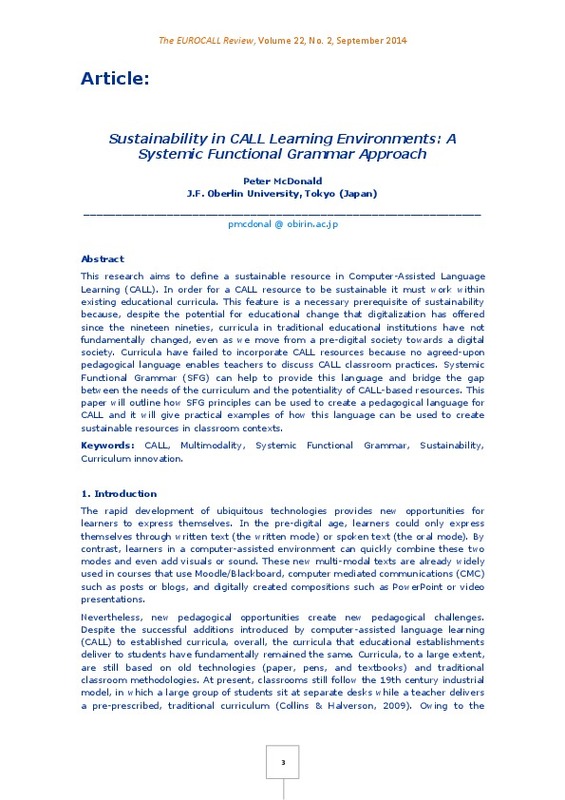Collins, A. & Halverson, R. (2009). Rethinking education in the age of technology. Columbia: Teachers College.
Cuban, L. (2001). Oversold and underused: computers in the classroom. Cambridge, MA: Harvard University Press.
DeVoss, D.N., Eidman-Aadahl, E., & Hicks, T. (2010). Because Digital Writing Matters. CA: John Wiley & Sons.
[+]
Collins, A. & Halverson, R. (2009). Rethinking education in the age of technology. Columbia: Teachers College.
Cuban, L. (2001). Oversold and underused: computers in the classroom. Cambridge, MA: Harvard University Press.
DeVoss, D.N., Eidman-Aadahl, E., & Hicks, T. (2010). Because Digital Writing Matters. CA: John Wiley & Sons.
Fries, P.H. (1994). On Theme Rheme and Discourse Goals. In M. Coulthard (ed.). Advances in Written Text Analysis. (pp. 229- 249). New York: Routledge.
Gee, Paul, (2011). Reflections On Empirical Evidence On Games and Learning. In T.Sigmund & J.D. Flechter (Eds.), Computer Games and Instruction. (pp. 223-232). Charlotte NC: Information Age Publishing
Hagood, M. (2008). Intersections of Popular Culture, Identities, and New Literacies. In J. Coiro et al (eds). Handbook of Research into New Literacies. (pp. 377-407). New York: Erlbaum.
Halliday, M.A.K. & Matthiessen, C.M.I.M. (2004). An Introduction to Functional Grammar. London: Hodder and Arnold.
Hoey, M. (2001). Textual Interaction. Oxon: Routledge.
Kennedy, C. (2013). Models Of Change and Innovation. In K. Hyland & C. Wong (Eds.), Innovation and Change In English Language Education. (pp. 13-27). Oxen:Routledge.
Kress, G. (2003). LITERACY IN THE NEW MEDIA AGE. doi:10.4324/9780203164754
Kress, G. & Van Leeuwen, T. (2006). Reading Images. London: Routledge.
Liu, J. (2004). Effects of Comic Strips on L2 Learners’ Reading Comprehension. TESOL Quarterly, 38(2), 225. doi:10.2307/3588379
Luke, C. (2001). Connectivity, Multimodality and Interdisciplinarity. In Reading Research Quarterly, Vol.38, No.3, 397-403.
Tim Marchand. (2013). Speech in written form? A corpus analysis of computer-mediated communication. Linguistic Research, 30(2), 217-242. doi:10.17250/khisli.30.2.201308.004
McCloud. S. (1994). Understanding Comics: The Invisible Art. New York: Harper Collins.
Mc Donald, J. Haward, J. Dobbin, N. Erskine, G. (2008). Macbeth: The Graphic Novel. Bristol: Classical Comics Ltd.
Miller, C.H. (2004). Digital Storytelling. Oxford: Elsevier.
Unsworth, L. (2008). Multiliteracies and Metalanguage: Describing Image Text Relations as a Resource for Negotiating Multimodal Texts. In J. Coiro et al. (eds). Handbook of Research into New Literacies. (pp. 377-407). New York: Erlbaum.
Royce, T. (2002). Multimodality in the TESOL Classroom: Exploring Visual-Verbal Synergy. TESOL Quarterly, 36(2), 191. doi:10.2307/3588330
Rutherford, W. E. (1987). Second Language Grammar and Teaching. New York: Pearson Education.
Stempleski, S. (2013). World Link: Developing English Fluency. Singapore: Cengage
Stenglin, M. and Iedema, R. (2001). How to Analyse Visual Images: A Guide for TESOL Teachers. In A. Burns. & C. Coffin. Analyzing English in a Global Context. (pp.194-208) London: Routledge.
Selfe, C.L. (2007). Multi-Modal Composition. NJ: Hampton Press.
[-]








